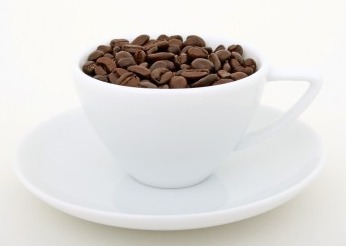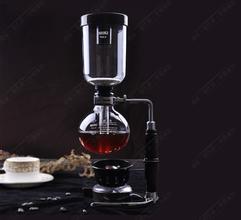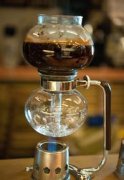Seven common brewing methods of coffee

a) General principles for brewing coffee
① Use freshly roasted coffee beans and store them for up to one week, preferably within one hour.
Store coffee beans in a light-proof container.
3. Freshly ground coffee beans before brewing.
Before use, you should put the tap water for a few seconds, and then use fresh cold water just from the tap. Bring the water to a boil, but not for too long (50 to 60 seconds), and don't pour boiling water over your coffee.
Coffee powder and water should be correct.
Use whatever method you like-plunger, drip, whatever-to make sure coffee has enough brewing time.
Drink immediately.
Remember to preheat the cup before pouring coffee.
b) Siphon brewing
As early as 1840, the British marine engineer Rob Nabil had invented the principle of siphon coffee pot, but it was not until the early 20th century that it developed into its current form.
Siphon brewing method, is the use of steam pressure principle, so that the heated cup, from a quite similar beaker, through the siphon and filter cloth flow upward, and then mixed with the coffee powder in the cup above, and the ingredients will be completely tempered out. After the fire source is removed, the coffee liquid flows back to the next cup again. Because the brewing process is full of fun, but also to enjoy the coffee tempering process, so more can add to the atmosphere of drinking coffee.
Siphon coffee pot before heating, must first pot outside the water droplets thoroughly wiped clean, in order to prevent heating, pot body will be uneven heating and rupture. After the coffee pot is used, it must be washed immediately with water to prevent residual coffee grease from adhering to the pot wall, and then placed in clean water, and then stored in the refrigerator.
① Pour appropriate boiling water into the flask (about 140CC per cup), because the coffee powder will absorb water, so the water should be a little more.
2 Fix the filter cloth above the upper cup. The new filter cloth should be boiled with coffee grounds before use.
3 When the hot water in the flask begins to boil, place the upper cup on the flask and let the boiling water rise to the upper cup.
Add some cold water and let the boiling water cool to about 90℃.
Add coffee powder and stir with a wooden spoon to mix the coffee powder with boiling water.
Stir and let stand for 45 to 60 seconds, then turn off the flame and let the coffee flow back into the flask.
c) Water drop brewing (ice drop)
Droplet coffee is also known as Dutch coffee. The earliest primitive form of the drip pot was invented in the early 19th century by Archbishop Dabello of Paris.
This method of brewing coffee is to use cold water or ice water to quench, let the water like water drops, at a rate of about 40 drops per minute, drop by drop slowly extract coffee essence. Because the speed is extremely slow, it should be used to quench the coffee powder. This coffee is brewed in a long-term manner and contains extremely low caffeine. Therefore, it is particularly refreshing to drink. In general cafes, the price of water drop word-of-mouth is 3 times that of ordinary ice, and reservations are required in advance.
① Put in ice cubes first, then pour in cold boiled water. Do not inject boiling water directly.
② First use deep-fried and finely ground coffee powder, pour it into the cylinder filter, and then gently press the coffee powder to fix it.
③ Fix the round filter paper special for the water drop coffee pot in the cylindrical filter.
④ Install the cylindrical filter and filter tube filled with coffee powder and filter paper to fix the filter on the bench.
5 After fixing the cylindrical filter, fix the jug on the stand that has been filled with ice water.
Adjust the amount of water in the drip plug, drip at a rate of about 40 drops per minute, and complete it after about 5 to 6 hours.
d) Italian coffee brewing
Italians drink 33 million cups of coffee a year, meaning coffee consumption per capita tops out at 600 cups. In the early 20th century, the world's first commercial coffee distiller was born in Milan. But it wasn't until 1930 that another Italian, Gadja, invented the spring-powered piston-lever still, which preserved the coffee's flavor and consistency to the maximum extent possible, and the process was so short that the coffee didn't have time to turn bitter or sour.
Now people can stop in for a cup of coffee on their way to work. In Europe and America, smartly dressed white-collar workers often sip breakfast from small china cups in small espresso bars before rushing to work.
Mocha coffee pot, also known as espresso pot, or napoli tower that coffee pot, this is a kind of coffee on the fire brewing appliances. It's sturdy and dexterous, and you've probably seen it in Italian kitchens. This coffee pot consists of two parts, the water is placed in the lower container, the pressure makes the water flow through the coffee into the upper container, and then pour out of this window. Though cute and nimble, it has only a few of the advantages of a piston pot and drip filter.
e) Filter paper brewing
Before the invention of filter paper coffee pots, people used sacks or metal nets as filters when brewing coffee. However, these methods can cause fine coffee grounds to fall into the cup, which in turn affects the taste. In addition, coffee grounds often remain on the filter and appear unsanitary, while destroying the original taste of coffee. So at this time, people do everything possible to drink more delicious coffee.
Until 1908, a housewife living in Dres, Germany-Melita Binz, she invented the filter coffee pot for her coffee-addicted husband. Because the filter paper can filter out all coffee grounds, and every time it is used up, there will be no problem of "residual coffee grounds", from then on people can easily drink clear, fragrant coffee.
When using filter paper coffee pot, fine ground coffee powder should be selected. If very fine ground coffee powder is used, the filter holes of filter paper will be blocked, and the coffee powder will be soaked for too long, which will affect the taste. If you use medium and coarse ground coffee powder, because the particles are larger and the water flow is faster, you cannot completely refine the fragrant alcohol components in coffee. In addition, when choosing a hot kettle, you should choose a kettle with a thinner mouth.
① Bend the bottom of the filter paper and the seal line next to it so that the filter paper can stick to the pot.
② Use hot water to wet the filter paper evenly so that the filter paper can be smoothly attached to the pot wall.
Add coffee powder. The coffee powder should be evenly distributed and a concave hole should be dug in the center.
④ Start boiling water from the center, slowly pour it on the coffee powder, and then wet the coffee powder.
Wait for the coffee powder to evaporate and expand. When the expanded part begins to sink, you can inject water again.
When injecting water for the second time, it should be injected slowly and in one go from inside to outside in a spiral manner.
f) Piston pot method (French press pot)
This is a pretty good way to make coffee. Many people like to brew coffee this way because it preserves the full flavor of the grind, which is difficult to do with other methods, and even makes the coffee taste of filter paper. The piston-pot used in the pressurization method is said to have been invented in 1933 by an Italian named Kaliman. To escape Italy during the war, he sold his designs and patents to Switzerland.
Using the piston-pot method is very simple. Preheat the pot, add the roasted coffee (about 5 grams per cup), add hot water and stir, soak for 4 to 5 minutes, push down the stainless steel piston with mesh, separate the coffee powder from the liquid, and finally pour the coffee juice from the piston pot.
You will find that the piston pot method can easily dispose of coffee grounds, so that you can fully enjoy 100% coffee flavor. Another advantage is that there are many models to choose from, so when you make breakfast coffee, you don't have to use an eight-cup pot. Its only drawback is that it doesn't keep warm.
g) Belgian pot brewing
There is a kind of boiler called Belgian coffee pot, which is said to be used by European princes and nobles in the past. Its principle is the same as that of the stopper, except that the upper and lower pots become side-by-side, with some mechanisms, and the lower pot (here should be said to be the right pot) is made of shiny copper or stainless steel, with a delicate faucet, which looks very beautiful, and of course the price is also very amazing. Coffee brewed in Belgian coffee pots has many drawbacks. First of all, when using this coffee pot, the coffee powder must be added at the beginning of brewing, and the pot with coffee powder is next to the alcohol lamp. By the time the water boils, the coffee powder will have been overheated. Second, there is a lid on the pot containing coffee powder, which cannot stir the coffee powder in the infusion. As a result, some coffee powder may not touch the water from beginning to end. Third, its alcohol lamp automatically went out after the water boiled, and there was no way to control the soaking time…
If it wasn't for collection, just to see how dazzling it was, then go to a cafe and order a pot to have fun.
moka pot
Strictly speaking, Italian mocha pot is not an appliance for brewing Espresso, because the steam pressure provided is only 1 1/2 to 3 atmospheres, and the brewing time is too long, which does not meet the requirements of Espresso. But because it is cheap, easy to operate, unique and diverse shape.
Although the mocha pot looks pleasing, simple and lightweight, but look closely at its brewing principle, in fact, is not a good coffee brewer. This boiling method tends to burn the coffee powder and extract bitter substances.
We emphasize that the reason why Espresso is currently the most ideal coffee brewing method in the world lies in its perfect balance of pressure and resistance as the core of the brewing principle, completely extracting all the aromatic substances in the coffee. The coffee powder in the coffee cake is not filled and cannot compete with the strong pressure that helps create, so that water easily flows through the coffee powder.
Important Notice :
前街咖啡 FrontStreet Coffee has moved to new addredd:
FrontStreet Coffee Address: 315,Donghua East Road,GuangZhou
Tel:020 38364473
- Prev

How to use siphon to make a good cup of coffee
1. The time of cooking-to know how to handle the siphon pot, for example, the time must be controlled within another 80 seconds, of course, it can be adjusted according to personal taste habits. It is recommended to rest for 15-20 seconds after the water boils up, and then stir every 15-20 seconds. Turn off the heat immediately after the third stirring and wrap the pot with a wet rag to cool quickly. I believe you can see the amber liquid drenched by the beautiful coffee mound! 2.
- Next

Siphon pot coffee brewing diagram illustrating the process of brewing coffee in a wind pot
The siphon pot (Syphon), also known as the plug pot, always seems to remind people of the utensils of chemical experiments. However, because they are all glass containers, the whole cooking process is clearly visible, which is an excellent brewing method with excellent visual effect. In terms of taste, it is also the favorite of some coffee lovers. At the same time, the whole brewing process will be filled with a very charming aroma of coffee. So, what are you waiting for? I'm coming.
Related
- What is the meaning of lactic acid fermentation with coffee bean treatment?
- How to judge the state of foam by sound?
- How does the latte pull out the unicorn pattern? Come to get for a little trick to improve the flower pull!
- Will flower pulling affect the taste of the latte?
- Do you know the history of coffee?
- The difference between honey treatment and sun washing what is raisin honey treatment?
- What kind of milk can a novice use to make coffee foam to keep the foam longer? The correct method and skills of milking tutorial sharing
- Why do washed coffee beans taste sour? Flavor characteristics of washed Coffee
- Introduction to the skill of how to practice the size and height of water injection around the circle of hand-brewed coffee
- How do beginners practice coffee flower drawing from scratch?

